Exploring Operations Strategy and Competitive Priorities in Business
VerifiedAdded on 2020/05/28
|6
|792
|111
Homework Assignment
AI Summary
This homework assignment delves into the fundamental principles of Operations Management, focusing on how businesses transform inputs into outputs through effective planning, organizing, and controlling of resources. It addresses the concept of competitive priorities which are crucial for setting a company apart from its competitors by managing time, cost, quality, and flexibility in business operations. The document highlights McDonalds as an example where quality is a core competitive priority, ensuring consistent product availability across various locations with high performance. Furthermore, it discusses order qualifiers and winners to explain how companies can secure and expand their market position. Lastly, the assignment explains productivity from an Operations Management perspective, defining it as the ratio of outputs produced to inputs used, thereby measuring the efficiency of business operations.
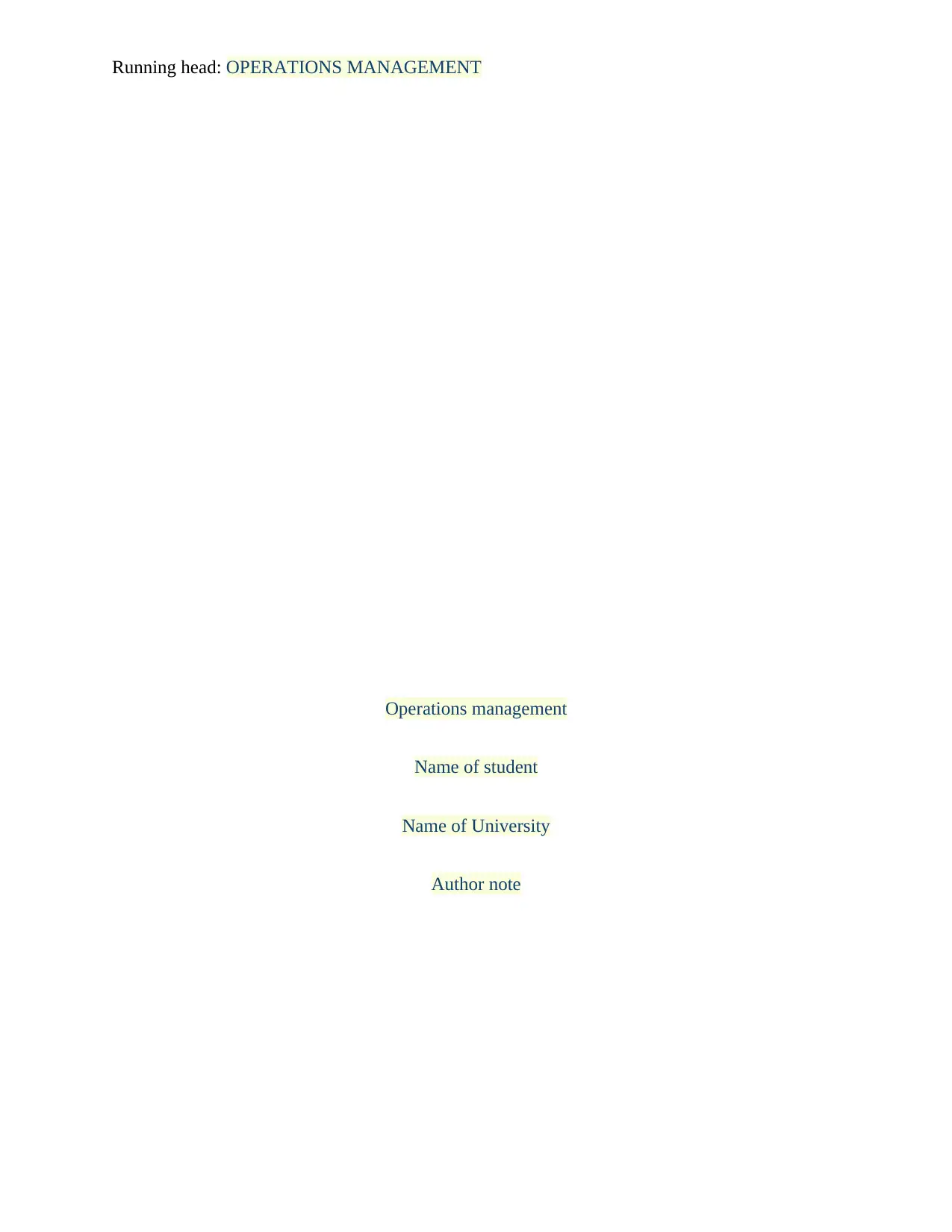
Running head: OPERATIONS MANAGEMENT
Operations management
Name of student
Name of University
Author note
Operations management
Name of student
Name of University
Author note
Paraphrase This Document
Need a fresh take? Get an instant paraphrase of this document with our AI Paraphraser
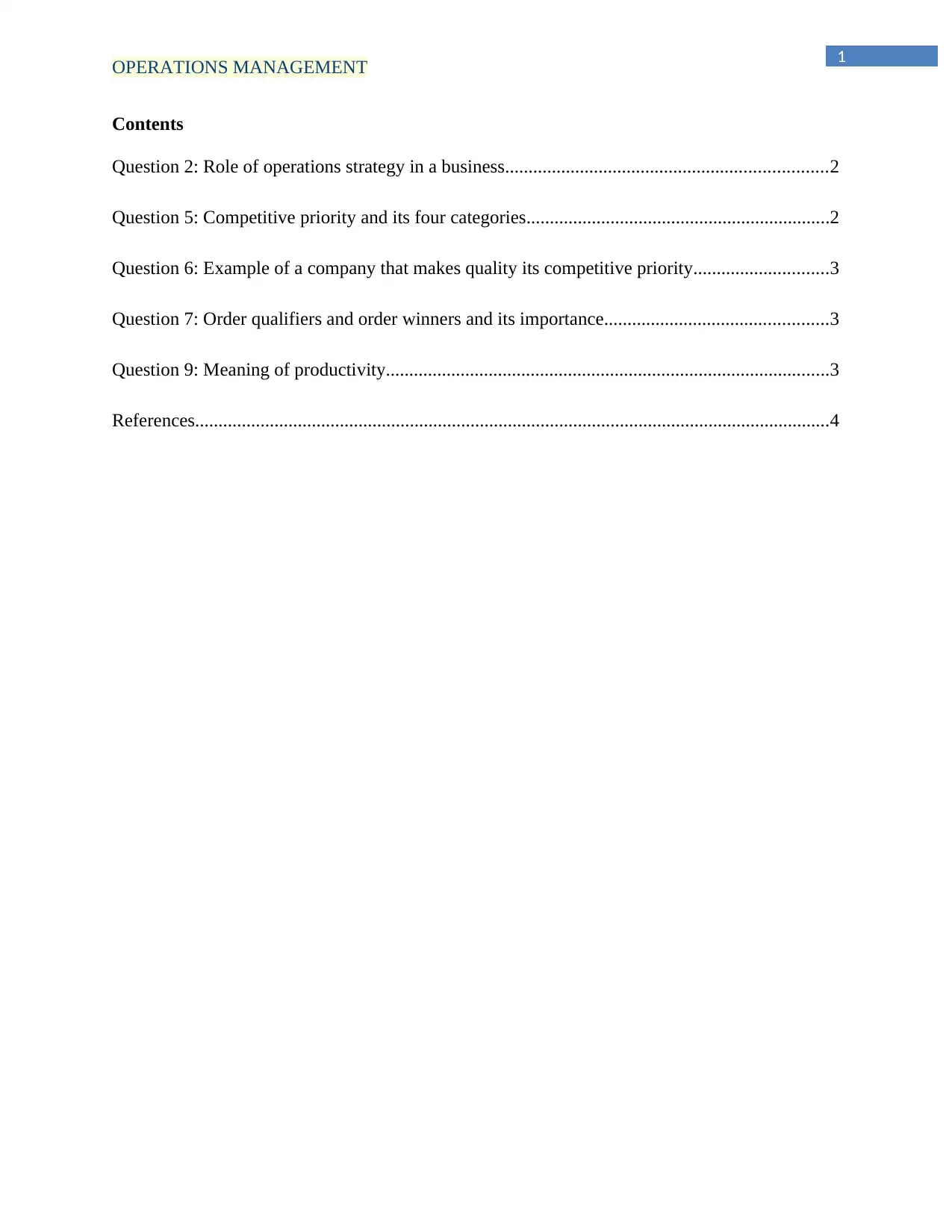
1
OPERATIONS MANAGEMENT
Contents
Question 2: Role of operations strategy in a business.....................................................................2
Question 5: Competitive priority and its four categories.................................................................2
Question 6: Example of a company that makes quality its competitive priority.............................3
Question 7: Order qualifiers and order winners and its importance................................................3
Question 9: Meaning of productivity...............................................................................................3
References........................................................................................................................................4
OPERATIONS MANAGEMENT
Contents
Question 2: Role of operations strategy in a business.....................................................................2
Question 5: Competitive priority and its four categories.................................................................2
Question 6: Example of a company that makes quality its competitive priority.............................3
Question 7: Order qualifiers and order winners and its importance................................................3
Question 9: Meaning of productivity...............................................................................................3
References........................................................................................................................................4
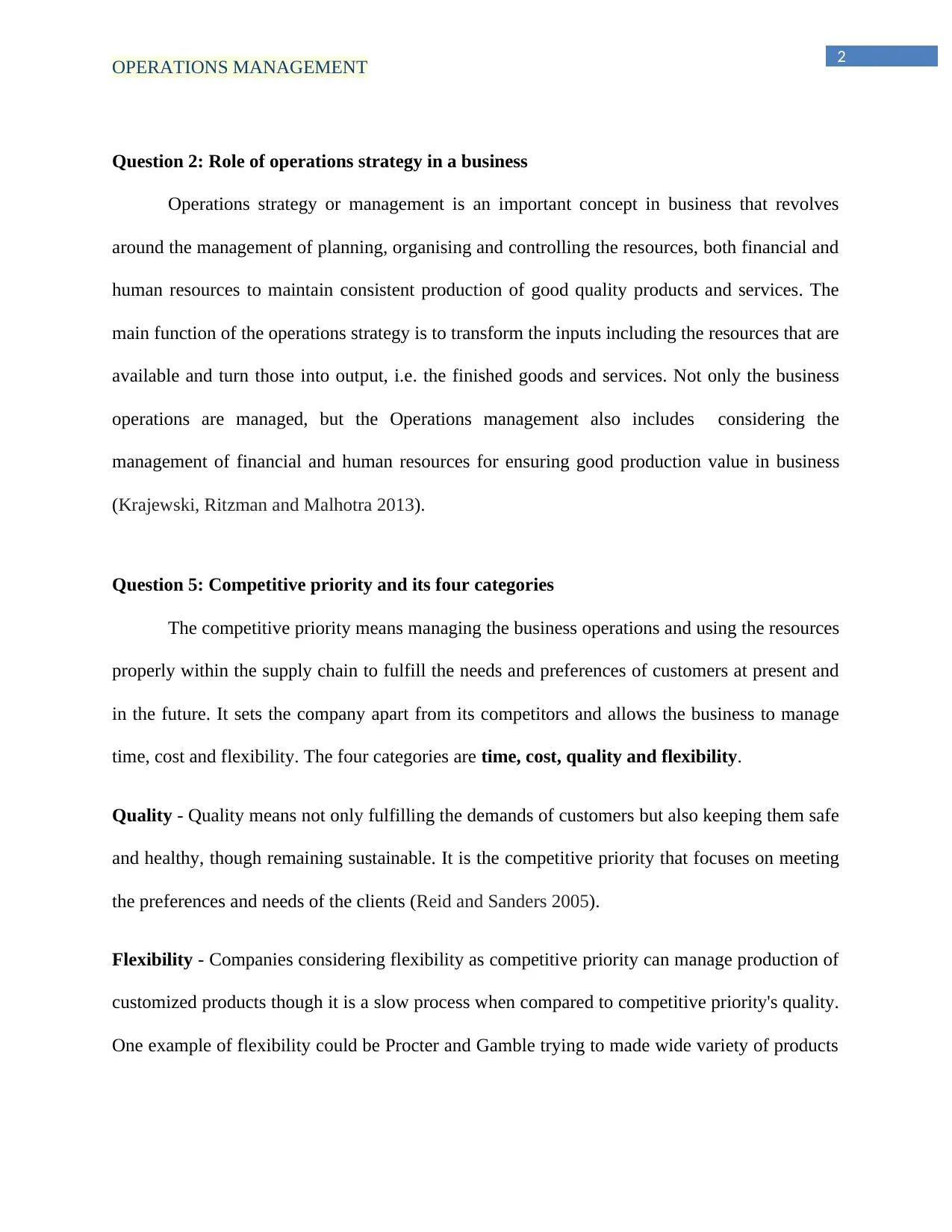
2
OPERATIONS MANAGEMENT
Question 2: Role of operations strategy in a business
Operations strategy or management is an important concept in business that revolves
around the management of planning, organising and controlling the resources, both financial and
human resources to maintain consistent production of good quality products and services. The
main function of the operations strategy is to transform the inputs including the resources that are
available and turn those into output, i.e. the finished goods and services. Not only the business
operations are managed, but the Operations management also includes considering the
management of financial and human resources for ensuring good production value in business
(Krajewski, Ritzman and Malhotra 2013).
Question 5: Competitive priority and its four categories
The competitive priority means managing the business operations and using the resources
properly within the supply chain to fulfill the needs and preferences of customers at present and
in the future. It sets the company apart from its competitors and allows the business to manage
time, cost and flexibility. The four categories are time, cost, quality and flexibility.
Quality - Quality means not only fulfilling the demands of customers but also keeping them safe
and healthy, though remaining sustainable. It is the competitive priority that focuses on meeting
the preferences and needs of the clients (Reid and Sanders 2005).
Flexibility - Companies considering flexibility as competitive priority can manage production of
customized products though it is a slow process when compared to competitive priority's quality.
One example of flexibility could be Procter and Gamble trying to made wide variety of products
OPERATIONS MANAGEMENT
Question 2: Role of operations strategy in a business
Operations strategy or management is an important concept in business that revolves
around the management of planning, organising and controlling the resources, both financial and
human resources to maintain consistent production of good quality products and services. The
main function of the operations strategy is to transform the inputs including the resources that are
available and turn those into output, i.e. the finished goods and services. Not only the business
operations are managed, but the Operations management also includes considering the
management of financial and human resources for ensuring good production value in business
(Krajewski, Ritzman and Malhotra 2013).
Question 5: Competitive priority and its four categories
The competitive priority means managing the business operations and using the resources
properly within the supply chain to fulfill the needs and preferences of customers at present and
in the future. It sets the company apart from its competitors and allows the business to manage
time, cost and flexibility. The four categories are time, cost, quality and flexibility.
Quality - Quality means not only fulfilling the demands of customers but also keeping them safe
and healthy, though remaining sustainable. It is the competitive priority that focuses on meeting
the preferences and needs of the clients (Reid and Sanders 2005).
Flexibility - Companies considering flexibility as competitive priority can manage production of
customized products though it is a slow process when compared to competitive priority's quality.
One example of flexibility could be Procter and Gamble trying to made wide variety of products
⊘ This is a preview!⊘
Do you want full access?
Subscribe today to unlock all pages.

Trusted by 1+ million students worldwide
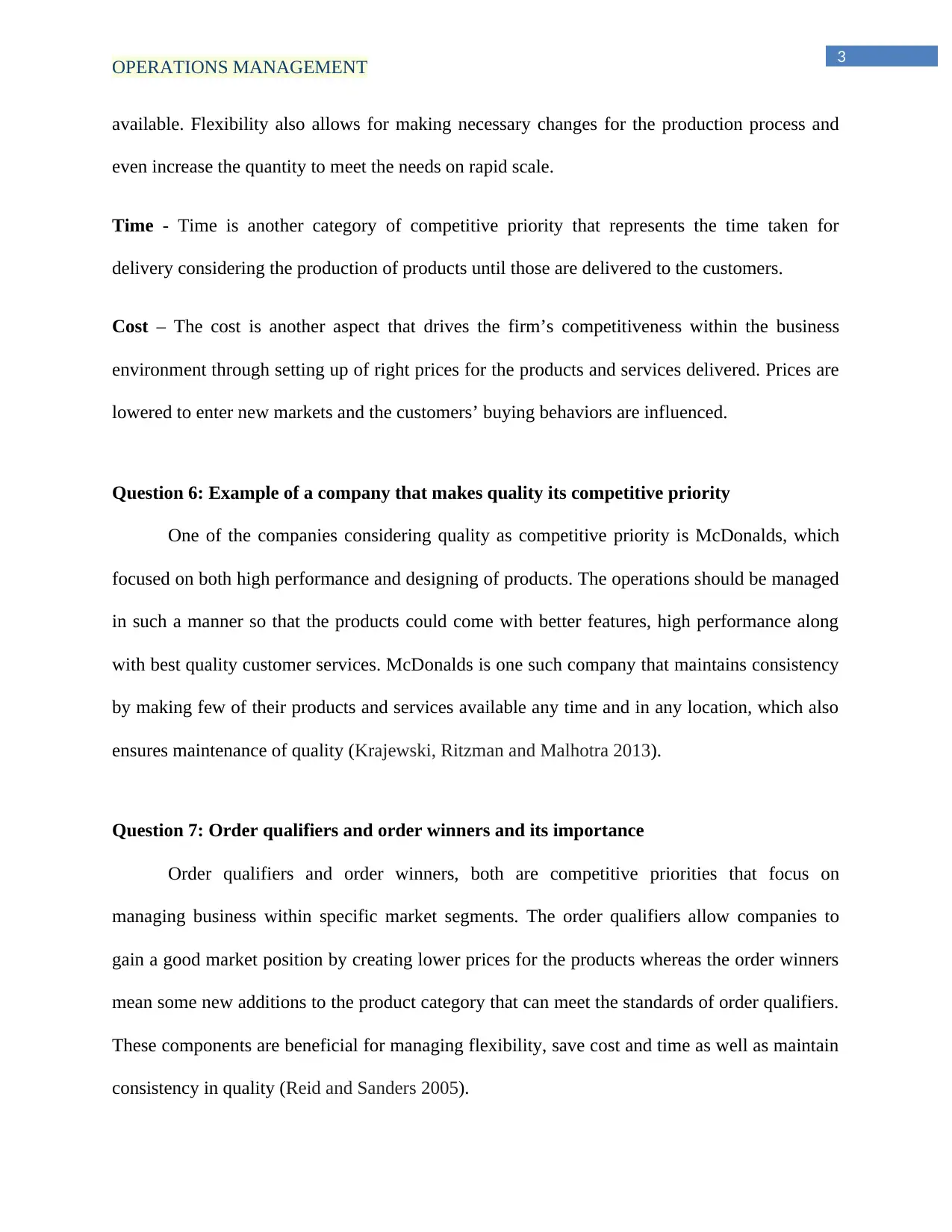
3
OPERATIONS MANAGEMENT
available. Flexibility also allows for making necessary changes for the production process and
even increase the quantity to meet the needs on rapid scale.
Time - Time is another category of competitive priority that represents the time taken for
delivery considering the production of products until those are delivered to the customers.
Cost – The cost is another aspect that drives the firm’s competitiveness within the business
environment through setting up of right prices for the products and services delivered. Prices are
lowered to enter new markets and the customers’ buying behaviors are influenced.
Question 6: Example of a company that makes quality its competitive priority
One of the companies considering quality as competitive priority is McDonalds, which
focused on both high performance and designing of products. The operations should be managed
in such a manner so that the products could come with better features, high performance along
with best quality customer services. McDonalds is one such company that maintains consistency
by making few of their products and services available any time and in any location, which also
ensures maintenance of quality (Krajewski, Ritzman and Malhotra 2013).
Question 7: Order qualifiers and order winners and its importance
Order qualifiers and order winners, both are competitive priorities that focus on
managing business within specific market segments. The order qualifiers allow companies to
gain a good market position by creating lower prices for the products whereas the order winners
mean some new additions to the product category that can meet the standards of order qualifiers.
These components are beneficial for managing flexibility, save cost and time as well as maintain
consistency in quality (Reid and Sanders 2005).
OPERATIONS MANAGEMENT
available. Flexibility also allows for making necessary changes for the production process and
even increase the quantity to meet the needs on rapid scale.
Time - Time is another category of competitive priority that represents the time taken for
delivery considering the production of products until those are delivered to the customers.
Cost – The cost is another aspect that drives the firm’s competitiveness within the business
environment through setting up of right prices for the products and services delivered. Prices are
lowered to enter new markets and the customers’ buying behaviors are influenced.
Question 6: Example of a company that makes quality its competitive priority
One of the companies considering quality as competitive priority is McDonalds, which
focused on both high performance and designing of products. The operations should be managed
in such a manner so that the products could come with better features, high performance along
with best quality customer services. McDonalds is one such company that maintains consistency
by making few of their products and services available any time and in any location, which also
ensures maintenance of quality (Krajewski, Ritzman and Malhotra 2013).
Question 7: Order qualifiers and order winners and its importance
Order qualifiers and order winners, both are competitive priorities that focus on
managing business within specific market segments. The order qualifiers allow companies to
gain a good market position by creating lower prices for the products whereas the order winners
mean some new additions to the product category that can meet the standards of order qualifiers.
These components are beneficial for managing flexibility, save cost and time as well as maintain
consistency in quality (Reid and Sanders 2005).
Paraphrase This Document
Need a fresh take? Get an instant paraphrase of this document with our AI Paraphraser
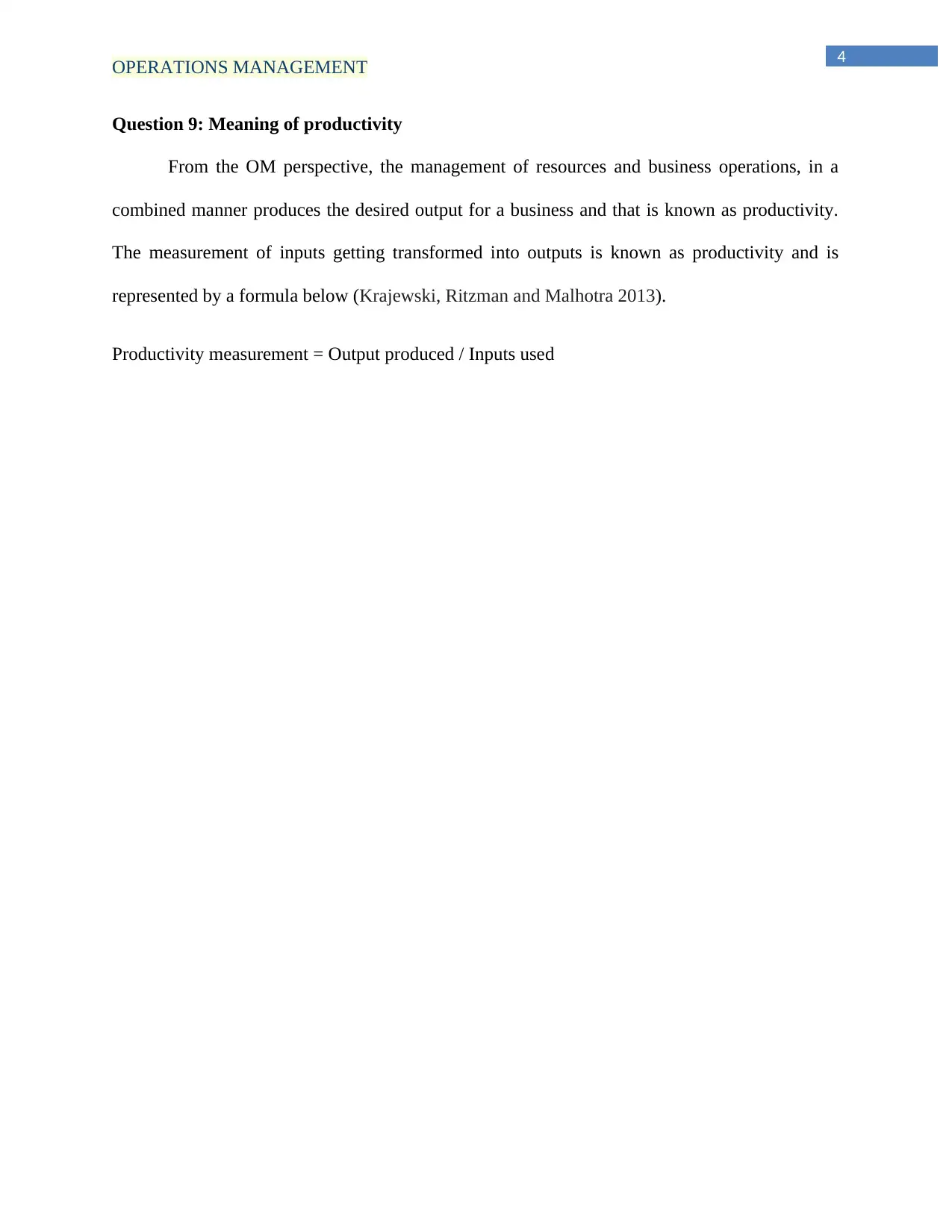
4
OPERATIONS MANAGEMENT
Question 9: Meaning of productivity
From the OM perspective, the management of resources and business operations, in a
combined manner produces the desired output for a business and that is known as productivity.
The measurement of inputs getting transformed into outputs is known as productivity and is
represented by a formula below (Krajewski, Ritzman and Malhotra 2013).
Productivity measurement = Output produced / Inputs used
OPERATIONS MANAGEMENT
Question 9: Meaning of productivity
From the OM perspective, the management of resources and business operations, in a
combined manner produces the desired output for a business and that is known as productivity.
The measurement of inputs getting transformed into outputs is known as productivity and is
represented by a formula below (Krajewski, Ritzman and Malhotra 2013).
Productivity measurement = Output produced / Inputs used
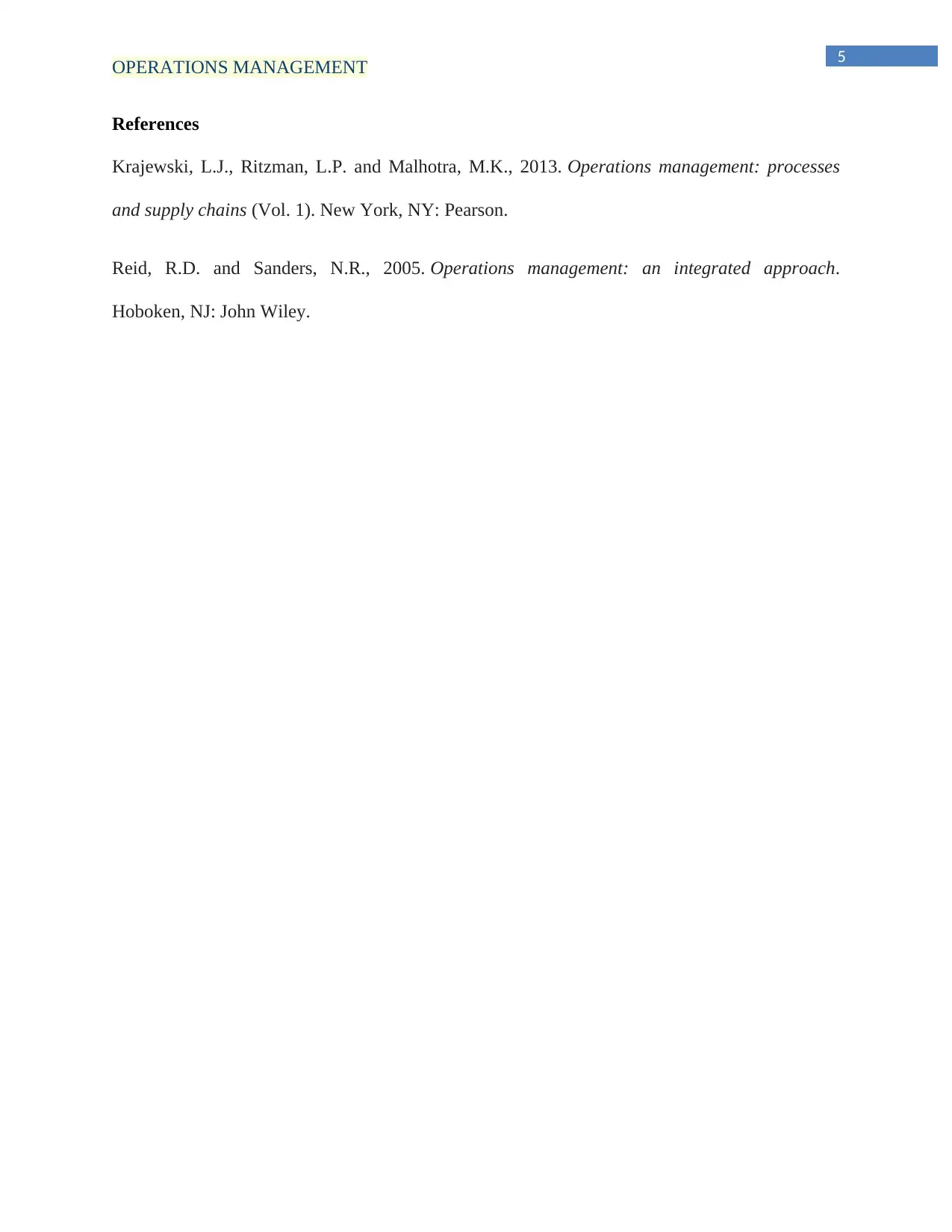
5
OPERATIONS MANAGEMENT
References
Krajewski, L.J., Ritzman, L.P. and Malhotra, M.K., 2013. Operations management: processes
and supply chains (Vol. 1). New York, NY: Pearson.
Reid, R.D. and Sanders, N.R., 2005. Operations management: an integrated approach.
Hoboken, NJ: John Wiley.
OPERATIONS MANAGEMENT
References
Krajewski, L.J., Ritzman, L.P. and Malhotra, M.K., 2013. Operations management: processes
and supply chains (Vol. 1). New York, NY: Pearson.
Reid, R.D. and Sanders, N.R., 2005. Operations management: an integrated approach.
Hoboken, NJ: John Wiley.
⊘ This is a preview!⊘
Do you want full access?
Subscribe today to unlock all pages.

Trusted by 1+ million students worldwide
1 out of 6
Related Documents
Your All-in-One AI-Powered Toolkit for Academic Success.
+13062052269
info@desklib.com
Available 24*7 on WhatsApp / Email
![[object Object]](/_next/static/media/star-bottom.7253800d.svg)
Unlock your academic potential
Copyright © 2020–2025 A2Z Services. All Rights Reserved. Developed and managed by ZUCOL.




